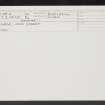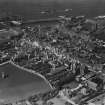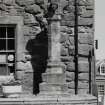Pricing Change
New pricing for orders of material from this site will come into place shortly. Charges for supply of digital images, digitisation on demand, prints and licensing will be altered.
Dunbar, High Street, Mercat Cross
Market Cross (16th Century)
Site Name Dunbar, High Street, Mercat Cross
Classification Market Cross (16th Century)
Alternative Name(s) Market Cross; Dunbar, Town House, Cross
Canmore ID 57664
Site Number NT67NE 6
NGR NT 67935 78917
Datum OSGB36 - NGR
Permalink http://canmore.org.uk/site/57664
- Council East Lothian
- Parish Dunbar
- Former Region Lothian
- Former District East Lothian
- Former County East Lothian
NT67NE 6 67933 78916
See also NT67NE 5.
'Cross at Town House. - In the south-eastern re-entering angle there stands a composite 'cross' made up of a 16th century octagonal shaft with symmetrical cap and base mouldings, surmounted by three skewputs bearing grotesque human heads, the whole crowned by a stone thistle. The fragments of which this object is composed are in no way related in date, but the skewputs are probably relics of the old parish church, which was replaced by the present modern structure on the same site (NT67NE 20). The shaft may well be that of the 'castle cross' referred to in the historical note on No.36 (NT67NE).
RCAHMS 1924
A weekly market was held in Dunbar every Thursday.
Watson 1711
'In 1369, Dunbar, by the Earl's (of Dunbar and March) influence, was created by David II, a 'free burrough' with limits as extensive as the Earldom of March, with a 'market cross', with power to buy and sell, with a cocquet and trone.'
G Chalmers 1888
NT 6793 7891. The cross is as described above. The shaft stands on a comparatively modern red sandstone three-tiered base.
Visited by OS (DT) 28 August 1962
Cross (NR)
OS 25" map (1977).
NT67NE 6 67923 78912
See also:
NT67NE 5 67941 78921 Dunbar Town House
Field Visit (25 May 1920)
In the south eastern re-entering angle there stands a composite ‘cross’ ([RCAHMS 1924], fig. 63) made up of a 16th century octagonal shaft with symmetrical cap and base mouldings, surmounted by three skewputs bearing grotesque human heads, the whole crowned by a stone thistle. The fragments of which this object is composed are in no way related in date, but the skewputs are probably relics of the old parish church, which was replaced by the present modern structure on the same site. The shaft may well be that of the ‘castle cross’ referred to in the historical note on No. 36 [RCAHMS 1924, 27].
RCAHMS 1924, visited 25 May 1920.


















